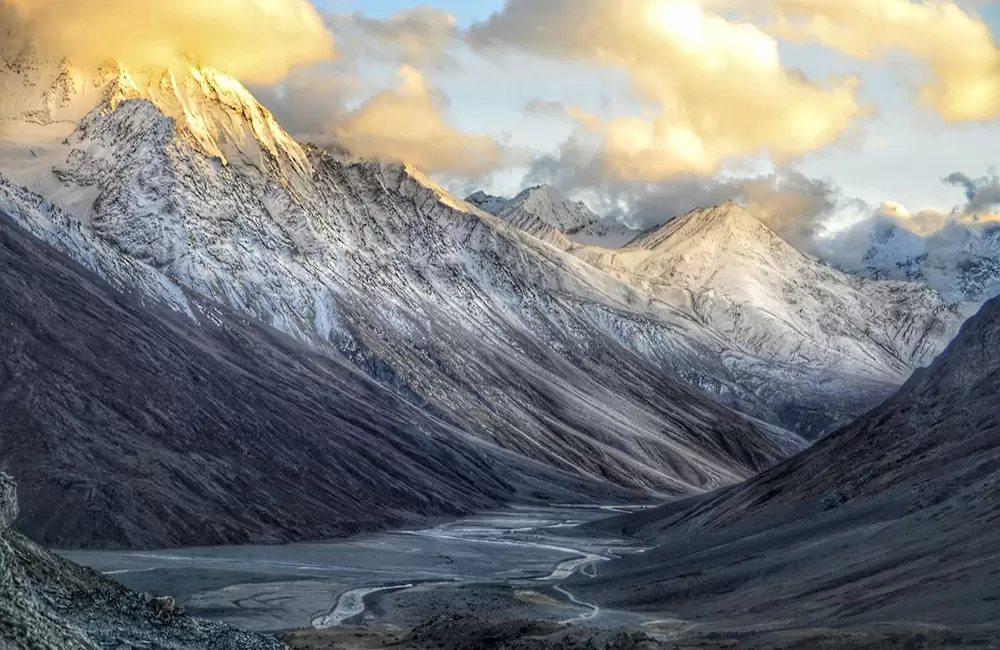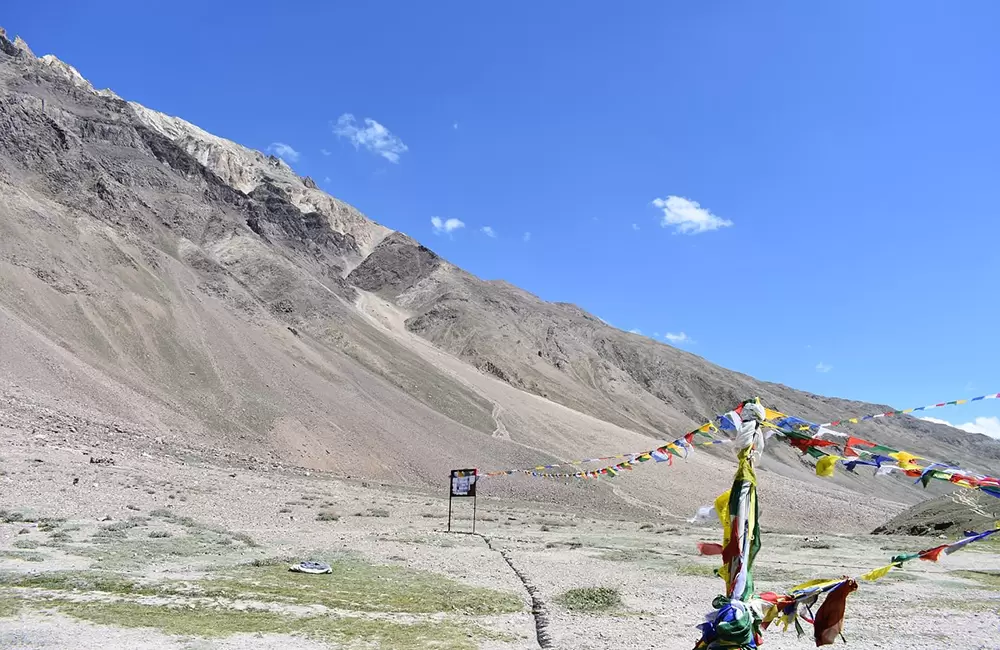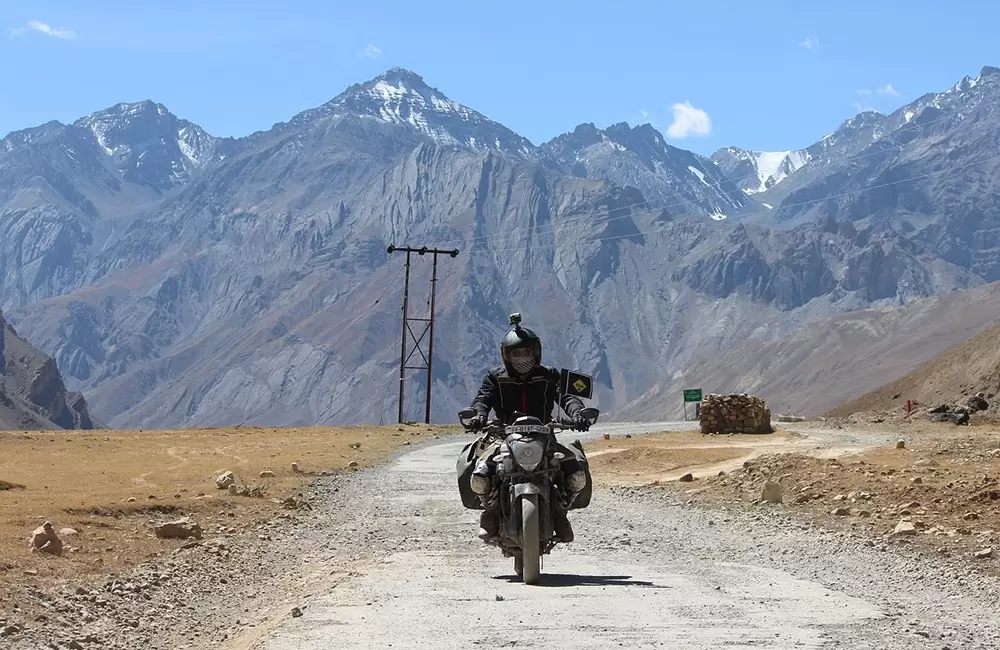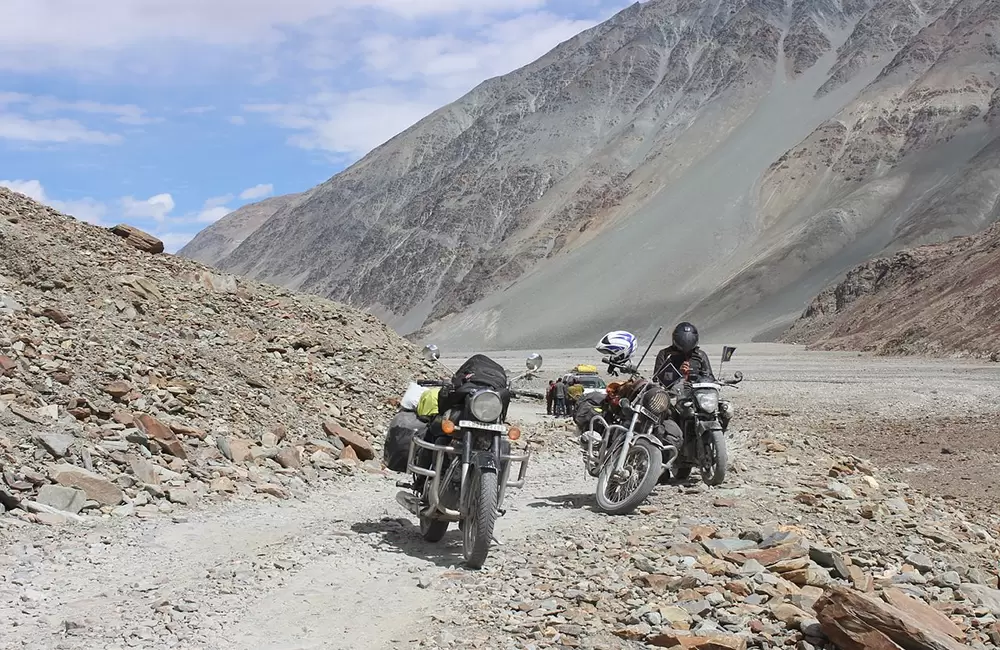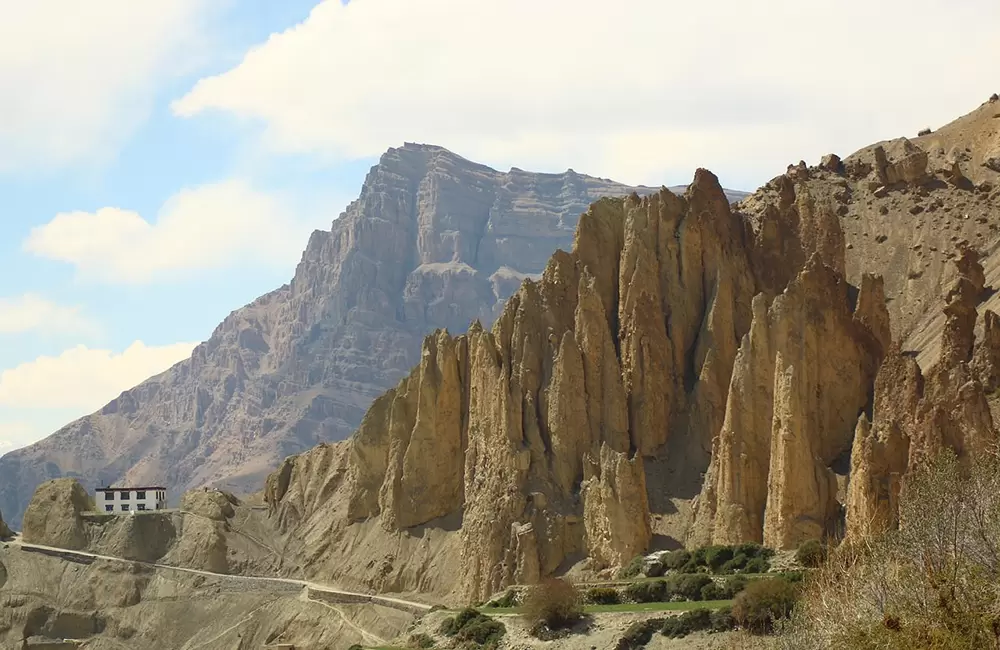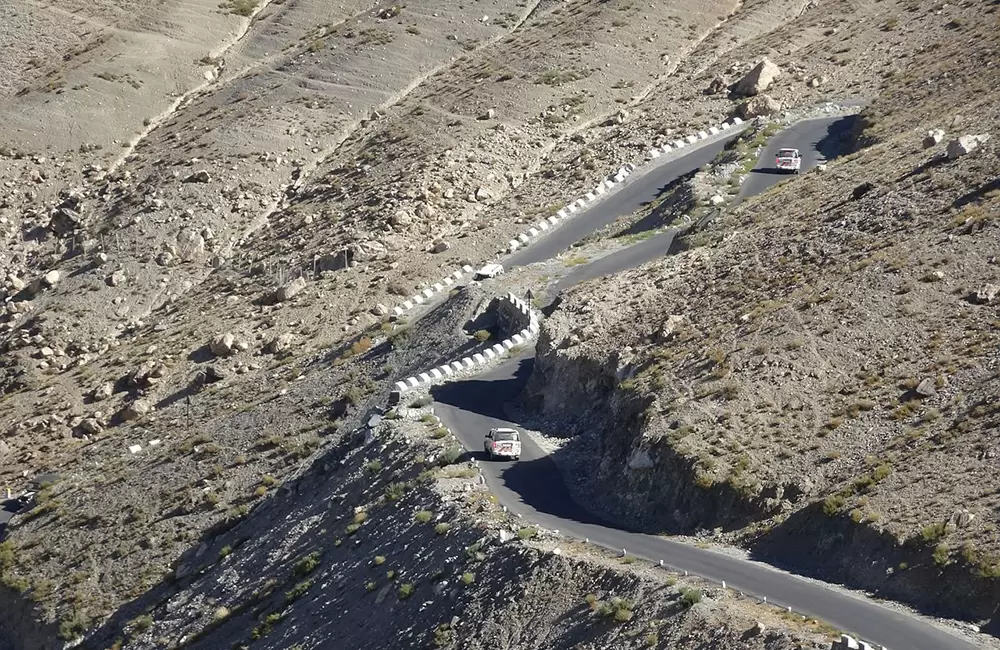The Spiti valley is a haven for adventure enthusiasts, with opportunities for trekking, mountaineering, and exploring ancient Buddhist monasteries like Key Monastery. Accessible primarily during the summer months, Spiti's serene environment and breathtaking vistas make it a perfect destination for those seeking solitude and natural beauty.
Spiti Valley is bordered by Ladakh to the north, Tibet to the east, Kinnaur to the southeast, and the Kullu Valley to the west. Its tranquil environment, stunning vistas, and myriad opportunities for photography, homestay tourism, and diverse adventure sports, including winter activities, make Spiti an ideal destination for those seeking solitude and natural beauty.
About Spiti Valley in Himachal
Spiti Valley, an expansive barren land of stark beauty, is situated at an average elevation of around 4000 meters. This cold desert region is renowned for its stunning Buddhist monasteries, vibrant prayer flags fluttering in the wind, and numerous monks engaged in prayer with their wheels. The valley is a treasure trove of Tibetan and Buddhist culture, housing some of the most revered monasteries in the world. The local language spoken by the natives is Stod Bhoti, but most residents are also proficient in Hindi and English, which is convenient for tourists. Many tourist guides are fluent in both languages, ensuring smooth communication.
Spiti Valley, with its unique landscape characterized by dramatic cliffs, deep gorges, and crystal-clear rivers, offers a picturesque setting for photography enthusiasts. This region is perfect for travelers seeking to immerse themselves in local culture, as homestay tourism is popular, providing a genuine experience of the local way of life and warm hospitality. Spiti Valley's serene environment and diverse attractions make it an ideal destination for those seeking both adventure and tranquility.
Spiti Valley as Adventure Destination
Spiti Valley is the ultimate adventure destination, offering thrill-seekers a range of adrenaline-pumping activities set against breathtaking landscapes. The rugged terrain and high-altitude trails provide a paradise for trekkers, with popular routes like the Pin Parvati Pass, Parang La, and the trek to Chandratal Lake. Mountain biking enthusiasts can tackle challenging off-road tracks, while river rafting on the Spiti River delivers an exhilarating rush. Riverside camping under the stars adds to the adventure, and trekking to Dhankar Lake offers a unique challenge.
During the winters, Spiti transforms into a snowy wonderland, ideal for ice climbing and snow trekking. The region’s serene environment and pristine snow-covered landscapes offer a unique backdrop for adventure. Nature enthusiasts can revel in bird watching and wildlife spotting, while the clear night skies provide spectacular stargazing opportunities. The valley's dramatic cliffs, remote villages, and ancient monasteries add to its charm, making it a rich cultural experience as well.
Activities in Spiti Valley
Spiti Valley is a haven for both nature lovers and adventure enthusiasts, offering a diverse array of activities that cater to every type of traveler. Whether you're seeking solitude or group adventures, Spiti's high-altitude landscapes and pristine environment provide the perfect backdrop. The valley's range of activities spans across seasons, from thrilling bike trips and exhilarating river rafting to serene camping under the stars and mesmerizing stargazing experiences. Spiti Valley truly has something for everyone, making it an ideal destination whether you're traveling solo or with a group.
To delve into the local culture, explore Tibetan markets for unique handicrafts and souvenirs, including colorful prayer flags and intricately woven carpets. For a truly unique experience, embark on a horse riding, yak safari, where you'll traverse the valley's rugged terrain on these sturdy animals, connecting with the region’s traditional nomadic lifestyle.
Here are some of the best and top activities in Spiti Valley :
- Bike Trip: Experience the thrill of a bike trip through Spiti Valley's rugged terrain and high-altitude roads. The winding paths, dramatic mountain views, and challenging routes provide an exhilarating adventure for cycling enthusiasts. Riding through the valley allows you to fully absorb the breathtaking landscapes and the serene beauty of this remote region.
- Rafting: Dive into the excitement of river rafting on the Spiti River. The river's fast-flowing currents and stunning surroundings create a thrilling and visually captivating experience. Whether you're a seasoned rafter or a beginner, the clear waters and dramatic gorges make this an unforgettable adventure.
- Camping: Set up your tent amidst the serene landscapes of Spiti Valley for a night under the stars. Camping in this high-altitude region offers an immersive experience in nature, with breathtaking views of snow-capped peaks, tranquil lakes, and star-filled skies. Whether you are a solo traveler or traveling with a group, camping is a perfect way to disconnect from modern life and enjoy the raw beauty of the Himalayas.
- Stargazing: Take advantage of Spiti Valley’s pristine night skies for stargazing. The region’s high altitude and minimal light pollution offer some of the clearest views of the night sky, making it ideal for observing constellations, the Milky Way, and other celestial wonders. It's a mesmerizing experience that highlights the vastness and beauty of the universe.
- Tibetan Shopping: Explore local markets and shops in Spiti Valley to find unique Tibetan handicrafts and souvenirs. From colorful prayer flags and intricate thangkas (traditional Tibetan scroll paintings) to handwoven carpets and silver jewelry, these items offer a glimpse into the region’s rich cultural heritage and provide memorable keepsakes of your visit.
- Yak Safaris: Experience yak safari, a unique way to explore Spiti Valley's stunning landscapes. Riding on these sturdy animals, you’ll traverse the valley’s rugged terrain and experience a traditional mode of travel used by locals. The safari provides an authentic connection to the region’s nomadic culture and breathtaking scenery.
- Visit Key Monastery: Visit the iconic Key Monastery, a significant spiritual and cultural landmark in Spiti Valley. Perched on a hilltop, the monastery is renowned for its ancient architecture, vibrant murals, and serene ambiance. Explore its ancient scriptures, attend prayer ceremonies, and enjoy panoramic views of the surrounding valley, making it a must-see for both spiritual seekers and history enthusiasts.
Staying in Spiti Valley
Staying in Spiti Valley offers a unique and immersive experience, with a range of accommodation options to suit different preferences and budgets. From cozy homestays that provide warm, local hospitality and a genuine insight into the region’s culture, to comfortable hotels and deluxe accommodations offering modern amenities, there is something for every traveler.
Homestays in particular are valued for their personalized service and the opportunity to engage with local families, enhancing your connection to the community. Whether you choose a charming guesthouse or a luxury hotel, your stay in Spiti Valley promises to be memorable, with breathtaking landscapes and welcoming hosts making your visit truly special.
Here are some accommodations, including hotels and homestays, where you can stay during your trip to Spiti Valley:
- Social Courtyard Spiti
- Zostel Spiti
- Spiti Village Resort
- Hotel Winter White Spiti
- Grease Moto Club Kaza
- SpitiDiaries
Spiti Valley Food Guide
Exploring the culinary landscape of Spiti Valley is a journey into the heart of Himalayan flavors and traditional cuisine. The region's food reflects its unique environment and cultural heritage, with hearty and wholesome dishes designed to sustain travelers in the high-altitude climate. Local cuisine features a blend of Tibetan and North Indian influences, offering an array of flavorful options from steaming momos and thukpa to rich, spicy curries and robust barley-based dishes.
Spiti Valley offers a delightful culinary journey with its unique blend of traditional Tibetan and local Himachali flavors. Indulge in dishes like Mokthuk, a comforting noodle soup with dumplings, and Madra, a spiced yogurt-based curry made with chickpeas or kidney beans. Thukpa, another hearty noodle soup, is perfect for the cold climate, while freshly caught Trout fish is a local specialty that shouldn't be missed. For beverages, try Chaang, a traditional barley-based alcoholic drink, or Quo and Arak, local spirits that provide warmth and a taste of the region's unique brews. The valley is also dotted with numerous cafes and restaurants, offering a range of local and international cuisines to cater to every palate, ensuring a memorable dining experience amidst the stunning Himalayan landscapes.
Here are some of the top cafes and restaurants in Spiti Valley where you can enjoy a meal:
- Mahabudha Restaurant
- Dragon Restaurant
- Cafe Kunzum Top
- Himachal Tourism Cafe
- Sachin Kunga Restaurant
History of Spiti Valley
Spiti Valley's history is marked by its strategic location and evolving political control. Originally part of Ladakh, Spiti was annexed by the East India Company in 1846 following the Anglo-Sikh War, becoming a part of British India. Due to its remote and resource-poor nature, the British largely retained the existing administrative structure, with the Nono of Kyuling serving as the hereditary Wizier responsible for local governance. This setup remained largely unchanged until 1941, when Spiti and Lahaul were combined into a separate sub-tehsil of the Kullu sub-division, headquartered in Keylong.
In 1960, the region was officially established as a district, with Spiti becoming a separate sub-division with its administrative center in Kaza. This historical progression highlights Spiti’s transition from a remote region under traditional rule to an integral part of modern administrative frameworks.
Spiti Valley Weather
Check out the Spiti Valley weather report for April
Spiti Valley Weather in April
The minimun and maximum temperature in April in Spiti Valley is -11°C and 2°C respectively. The weather is generally snowfall in April and you would feel chilling cold throughout the day. Heavy Woolen clothes are recommended for Spiti Valley in April.
